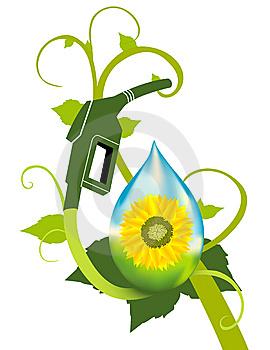If you drive a diesel vehicle in the Bay Area, you may have noticed something a little different at your Propel Fuels station. For the first time, Propel has started selling a biodiesel blend partially made from algae.
如果你在舊金山灣區駕駛柴油車,也許你會注意到 Propel 燃料站與以往有所不同。Propel 公司首次開始售賣以藻類為部分原材料加工而成的混合生物柴油。
That's right. A photosynthetic microorganism was turned into fuel without having to die, be buried in sediment and cooked by eons of geologic processes into petroleum. Instead, the company Solazyme simply grows its algae in the dark, on a sugar diet. Starved of light, the algae digest sugar and produce oil, which the company harvests.

你說對了。活著的光合微生物群能轉變為燃料,并不需要將它們埋藏在沉積物里,經歷上百萬年的地質進程,然后轉變為石油。作為替代,Solazyme 公司在黑暗,以糖為養分的環境里培育藻類植物。因為極度缺乏光照,所以藻類吸收糖分,生產出石油,Solazyme 公司以此盈利。
It's all part of an ongoing effort to make low-carbon fuels to replace diesel, gasoline and jet fuel. The idea is simple: the algae or other plants suck up CO2 when they grow, the same CO2 that is released when the fuel made from the algae is burned. So there's no net addition of the greenhouse gas to the atmosphere.
用低碳燃料代替柴油、汽油和航空煤油的研究仍在繼續。道理其實很簡單:藻類或其他植物生長時吸收的二氧化碳,其實與藻類燃燒變成石油釋放的二氧化碳等量。因此不會向大氣釋放額外的溫室氣體。
Solazyme is hardly alone. Companies like Kior and Ineos are using chemical and biological methods to turn wood into fuel. And experimental algae farms are springing up in San Diego and the deserts of New Mexico. The fuel of the future might not need epochs worth of fossilized sunshine, fulfilling some of the promise of advanced biofuels.
Solazyme 公司并不是唯一這樣做的公司。像 Kior 和 Ineos 這樣的公司也在應用化學和生物方法將木材轉化為燃料。在圣地亞哥和新墨西哥州的沙漠里,海藻實驗農場如雨后春筍般涌現。未來可能是不以“石化”陽光為貴的石油時代,先進的生物燃料的興起也會得以實現。












